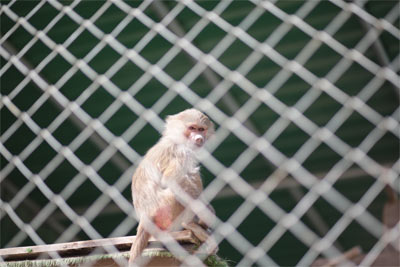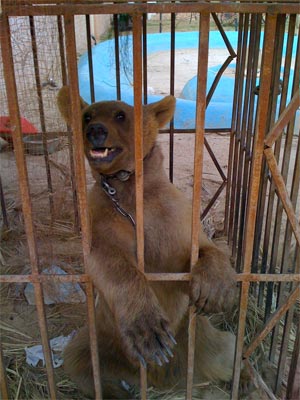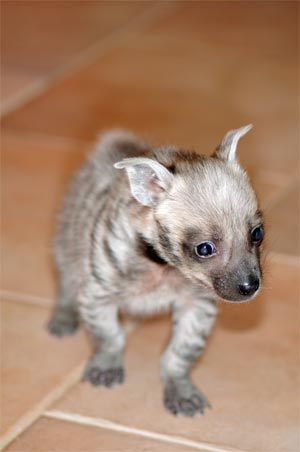In February of this year, K’S PATH received a call about a Hamadryas baboon on the loose in the Friday market. Baboons of this kind tend to compete fiercely for resources, and can be particularly dangerous around food. They are also potential vectors for an astounding number of diseases that affect humans, including rabies, herpes, hepatitis b, HIV, and tuberculosis, to name but a few. A baboon on the loose in a public place, struggling to survive in stressful, unnatural conditions, therefore represents a serious risk to human health. Two of the K’S PATH animal control units therefore quickly responded to the call.

On arriving at the market, we were directed to the Shrimpy’s restaurant, where she had last been sighted. A thorough search of the building, including the roof, led nowhere. Several hours of searching the area around the market and talking to people revealed little except word of an occasional sighting. Eventually we were obliged to go back to our other duties and see what developed.
Later, we received a frantic call from one of the people we had spoken to earlier that day: the baboon was inside Lu & Lu Hypermarket, and people were panicking. This time K’S PATH mobilized all of our units and several volunteers, under the assumption we would have to use a dart gun to catch a baboon inside a crowded supermarket; a very dangerous prospect. By the time we arrive at the scene however, workers had chased the baboon back outside. Now we were faced with the prospect of finding and catching a primate in the dark, in a huge open area. Fortunately, we are experts in animal capture, so we went with our training. With such a recent sighting, we were able to more or less track the animals’ movements through eyewitness accounts. This led to a small cluster of buildings near the main entrance to the manufactured-goods area of the market. Here the trail went cold.
We split up with flashlights and headlamps to see what we could find. The first search revealed nothing. We were just about ready to give up. I was on top of the middle building creeping around looking for what I hoped wasn’t an angry primate, when the beam of my flashlight caught the slightest smudge in the dust inside of an air conditioning unit. A closer look revealed the slight impression of three little baboon prints.
The tracks went in, but they didn’t come out. It appeared that she had settled down for the night in the labyrinth of duct work in an unfinished bank. So we rustled around the building trying to narrow down the location, but she didn’t make a sound. I decided to plan for every eventuality, and we made holes in the duct work inside the building, set a humane-live-trap inside, and sealed off every opening. We also set traps outside on the chance she might still be loose. Then we settled down to a waiting game, going home and sending staff periodically to check the traps. Almost 24 hours later, we were finally successful. We had an unharmed baboon in a trap.
The story does not end here, however. A baboon lives approximately 35 years, and K’S PATH is now faced with the prospect of caring for yet another baboon, at least our 15th in the last 5 years. But keeping them is no easy endeavor. They are particularly dangerous in groups, and their housing and upkeep are expensive. The K’S PATH sanctuary does not currently enjoy any government or corporate funding, and our options grow more limited with every new wild animal.
In 2012, poachers killed 668 Rhinos in South Africa– the highest number ever recorded. This figure represents a significant upward trend in rhino deaths driven by demand for their horn in China and Vietnam. Meanwhile, elephant poaching is at its highest rate ever, also driven primarily by Chinese demand for ivory. The list continues. It is now estimated that more than 100 million sharks are killed for their fins each year; scientists are now confidently predicting the collapse of many shark fisheries. Meanwhile, poaching of big cats (primarily cheetahs) is on the rise, driven by demand from the Middle East. Simply put, the populations of these and many other species are in crisis, and if we don’t act quickly and firmly, humans will once again cause the extinction of another species.
This month, the Convention on International Trade in Endangered Species of Wild Fauna and Flora (CITIES) will meet in Bangkok to seek solutions to these and other issues related to wildlife. More than 170 countries have signed into the convention, thereby promising to abide by it’s agreed upon policies to protect flora and fauna from over-exploitation. Among these countries is the State of Kuwait.
As a signatory to the convention, Kuwait has agreed to monitor and regulate all of the more than 30,000 species protected by the convention. What this means on a basic level is that signatories to the convention must provide protection to listed species. Signatory governments therefore cannot allow the movement or trade in any individual of a species or product derived from any species considered threatened, endangered, or otherwise protected. At the very least, this means inspections at all border crossings, seizure of plants, animals, or products in violation, and care of all living specimens until an alternative arrangement can be found. It also means routine inspection and regulation of live animal and online animal markets.
Unfortunately for the species affected, Kuwait is currently failing to meet virtually all of its obligations under the CITIES agreement. Law enforcement officers are either not aware of the rules or choose not to enforce them. If they did enforce the rules, there still would be no place to put seized animals until their future could be decided (the zoo is not adequate in any way, not the least of which is volume). Perhaps the most glaring and public failure to comply with the convention is the presence of illegal wildlife in the so-called ‘Friday Market’ and their listing on public online forums. In fact, you can buy almost any animal in Kuwait.
In 2009, our undercover investigators conducted a sting operation that revealed a Eurasian Brown bear, an African Cheetah, a striped hyena, flamingos, several hundred venomous snakes, and several protected parrots for sale on a farm in Kebd. The man selling these animals also listed other animals he could bring, along with their prices. The list included critically endangered White Lions. In that instance, the zoo was in need of a bear and so the law forbidding the sale of wildlife was enacted. He was allowed to keep the other animals. Unfortunately, confiscation of illegal wildlife is all too rare.

2009 K’S PATH bear seizure
Meanwhile, a weekend visit to the Friday market will usually reveal wild-caught African Grey parrots, desert tortoise, African crocodile, a wide-range of locally caught birds (all protected by local law), and Hamadryas baboons originating in Saudi Arabia. One can also find vervet, macaque, and other more exotic species on a less regular basis. The list goes on and on. These sales are able to take place in public because there is no fear of repercussion.
The trade in illegal wildlife is of global concern, and it has very real implications in Kuwait. There is still hope, but only if we all start working together. Visit www.facebook.com/kspathq8 or www.kspath.org to see how you can get involved

2010 K’S PATH Hyena Rescue
Post by John Peaveler
Managing Director
Kuwait Society for the Protection of Animals and Their Habitat (K’S PATH)

11 replies on “It’s a zoo out there”
HIV infection can never be transmitted from Baboons to Humans
i looooooooove ks path and the tremendous effort they are doing to protect animals. lovely article.
https://wwwnc.cdc.gov/eid/article/18/2/11-1309_article.htm
https://www.nature.com/scitable/knowledge/library/non-human-primates-retroviruses-and-zoonotic-infection-59119998
Never is a very dangerous word when you are talking about disease transmission.
Baboons are certainly carriers of HIV, and humans can be infected with HIV. Whether the virus transmits easily between the two species is hardly even worth contemplating. Baboons and other wildlife pose a clear and direct threat to human health. In a growing world, disease and virus transmission between humans and other animals will continue to increase. No one wants to be either the first or the last person to contract any life-changing or life-ending disease.
Before there was HIV, there was SIV (Simian Immunodeficiency Virus) and it made the jump to humans from our simian friends. Research before making sweeping comments.
I appreciate your efforts but unfortunately our over funded, lazy, middle school educated police can’t bother enforcing basic laws of dangerous speeding let alone crack down on the illegal pet trade.
Great job in locating and catching the baboon alive and unharmed. Keep up the good work and never ever give up!
Hi John,
We are indeed blessed to have a trained expert like yourself involved in animal rescue and animal welfare in a country like Kuwait. The baboon mentioned in the article is lucky to have been given a chance to live, due to your expertise on the subject matter. I had a chance to visit K’s path this Sat and did see the baboon in the enclosure – calm and composed. I dint really know the story behind it until now, amazing job.
Thank you for making this place a little better by devoting your time and efforts selflessly and saving God’s wonderful creation.
I once got a frantic call from a friend who found an African Grey parrot in his yard. He called us up since he knew my dad has a passion for birds. It was extremely distressd and had a wing injured. That was 12 years ago. Today he is a healthy fellow who has made himself (we did a DNA test) at home at our place. His wing has since healed and he flies around the house quite freely. My question is when we are taking him out of the country, what are the papers we would require? A few people mentioned a CITES certificate. How do we go about obtaining it? I was under the impression it is issued in the place where it is imported from originally, which in the case of most African Greys in Kuwait is Johannesburg, South Africa.
The website is down for some reason but you didn’t mention how we can donate to KSPath??
So u accept corporate sponsers
Apologies for the technical difficulties, but we are in the process of launching a new website.
The easiest way to donate to K’S PATH is to join us at one of our events or to leave a donation at the shelter. You can also deposit directly into our account. In many cases we are happy to collect donations or to arrange a drop off point in the city.
We do accept corporate sponsors, and we would be happy to discuss sponsorship of an event or portion of our operations. Sponsorship packages are available on request.
Thank you for your interest and for your support.
Regarding the African Grey, it may only be shipped if it was a legally obtained individual in the first place. If it was poached from the wild, it may not legally leave the country. You must therefore have breeding papers. You can visit the PAAFR location in Al Rai to pursue this.